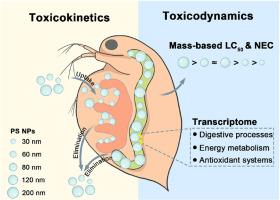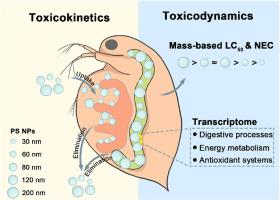毒性动力学模型揭示了不同尺寸聚苯乙烯纳米塑料的生态风险
IF 7.3
2区 环境科学与生态学
Q1 ENVIRONMENTAL SCIENCES
引用次数: 0
摘要
纳米塑料在水生生态系统中具有重大的生态风险,但其环境安全阈值尚未明确界定。本研究采用毒性动力学-毒性动力学(TK-TD)建模框架,研究了30- (PS30)、60- (PS60)、80- (PS80)、120- (PS120)和200-nm (PS200)聚苯乙烯(PS) NPs在大水蚤中的生物蓄积和毒性。必要时用聚集诱导排放的氟化物标记PS NPs,从而能够精确跟踪其生物积累。荧光成像显示,较大的PS NPs主要积聚在肠道,而较小的颗粒优先定位于胸廓附属物。除PS120外,吸收和消除率随粒径的增大而增加,PS120的消除率最低,可能是由于被困在肠道内。毒性评估表明,较小的PS NPs具有更高的毒性,破坏营养消化并诱导氧化应激,转录组分析证实了这一点。利用TK-TD模型,我们预测PS30、PS60、PS120、PS80和PS200的48小时LC50值分别为1.2、3.0、13.5、14.4和196.7 mg L−1。相应的无效应浓度分别为0.15、1.05、6.9、8.2和92.7 mg L−1。总的来说,我们的研究建立了一个TK-TD框架来预测受控条件下PS NPs的毒性,为未来的环境风险评估提供基础数据。本文章由计算机程序翻译,如有差异,请以英文原文为准。


Toxicokinetic-toxicodynamic modeling reveals the ecological risks of differently-sized polystyrene nanoplastics
The nanoplastics (NPs) in aquatic ecosystems poses significant ecological risks, yet their environmental safety thresholds remain poorly defined. Here, we employed a toxicokinetic-toxicodynamic (TK-TD) modeling framework to investigate the bioaccumulation and toxicity of 30- (PS30), 60- (PS60), 80- (PS80), 120- (PS120), and 200-nm (PS200) polystyrene (PS) NPs in the zooplankton Daphnia magna. The PS NPs were labeled with aggregation-induced-emission fluorogens when necessary, thereby enabling precise tracking of their bioaccumulation. Fluorescence imaging revealed that larger PS NPs primarily accumulated in the gut, whereas smaller particles preferentially localized on thoracic appendages. Both uptake and elimination rates increased with particle size, except for PS120, which exhibited the lowest elimination rate, likely due to entrapment in intestines. Toxicity assessments indicated that smaller PS NPs exhibited higher toxicity, which disrupted nutrient digestion and induced oxidative stress, as evidenced by transcriptomic analyses. Using the TK-TD model, we predicted the 48-h LC50 values for PS30, PS60, PS120, PS80, and PS200 to be 1.2, 3.0, 13.5, 14.4, and 196.7 mg L−1, respectively. The corresponding no-effect concentrations were 0.15, 1.05, 6.9, 8.2, and 92.7 mg L−1. Overall, our study establishes a TK-TD framework to predict the toxicity of PS NPs under controlled conditions, providing foundational data for future environmental risk assessments.
求助全文
通过发布文献求助,成功后即可免费获取论文全文。
去求助
来源期刊

Environmental Pollution
环境科学-环境科学
CiteScore
16.00
自引率
6.70%
发文量
2082
审稿时长
2.9 months
期刊介绍:
Environmental Pollution is an international peer-reviewed journal that publishes high-quality research papers and review articles covering all aspects of environmental pollution and its impacts on ecosystems and human health.
Subject areas include, but are not limited to:
• Sources and occurrences of pollutants that are clearly defined and measured in environmental compartments, food and food-related items, and human bodies;
• Interlinks between contaminant exposure and biological, ecological, and human health effects, including those of climate change;
• Contaminants of emerging concerns (including but not limited to antibiotic resistant microorganisms or genes, microplastics/nanoplastics, electronic wastes, light, and noise) and/or their biological, ecological, or human health effects;
• Laboratory and field studies on the remediation/mitigation of environmental pollution via new techniques and with clear links to biological, ecological, or human health effects;
• Modeling of pollution processes, patterns, or trends that is of clear environmental and/or human health interest;
• New techniques that measure and examine environmental occurrences, transport, behavior, and effects of pollutants within the environment or the laboratory, provided that they can be clearly used to address problems within regional or global environmental compartments.
 求助内容:
求助内容: 应助结果提醒方式:
应助结果提醒方式:


